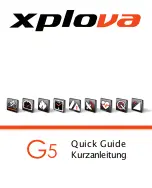
25
do they signal. The key factor here is neglecting to look to the
rear. If the cyclist had looked, he/she would have seen the
danger coming up from behind.
What can you do?
Of course, you ought to teach your child
not to ride across busy streets - at least until the child has had
some ad vanced training and is old enough to understand
traffi c. But in the meantime, for residential street riding, you
can teach your child to always look
and
signal before turning
left. A big part of this lesson is teaching the child how to look
to the rear without swerving.
Take your child to a playground or a safe area away from
traffi c or obstructions to prac tice riding along a straight line
while looking behind. Stand alongside and hold up a different
number of fi ngers on your hand after the child rides by. Call
his/her name. After 15 minutes of prac tice, a ten year old
should be able to look behind his/herself and identify how
many fi ngers you are holding up - without swerving.
d. Riding
at Dawn, at Dusk or at Night
(See also Section 4.F, page 19).
Most car/bicycle accidents happen at night where an
overtaking car hits a bike. (An overtaking car is one that
comes up from behind and passes the cyclist on the left.)
These overtaking accidents can be very serious.
What can you do?
First, you should keep your youngster
from riding at dawn, dusk or at night. It requires special skills
and equip ment. Few children have either. Secondly, make
sure your child understands that if he/she gets caught out at
dusk or after dark on a bike, the thing to do is to call you for a
ride home. One suggestion is to tape a phone number and
money to the bike so that, in an emer gen cy, the child will be
able to call home.
e. Following the Leader
There is increased risk of car/bike collision if children are
following each other, because if the fi rst one does something
dangerous, those following may do it too.
What can you do?
Teach your child to always assess the
traffi c situation for him/herself. When a group is riding around,
each cyclist should stop for stop signs; each cyclist should look
to the rear before making left turns; and so on. One way to
get the message across is to play a game with the child similar
to ‘Simon Says’. In this game, however, the emphasis should
not be on doing what ‘Simon Says’, but rather have the child
make a decision based on the situation. The child should learn
to ignore what ‘Simon Says’. Children need to learn to think
for themselves to ride safely.
SUMMARY
Teach your child early - the earlier the better. Learning skills
such as looking and avoiding hazards takes time. Be prepared
to repeat lessons until your child understands what you’re
trying to get across. Be patient. Your efforts will be rewarded,
knowing that your child is aware of safe riding skills.
Содержание 06.DB
Страница 2: ...Serial Number Locations ...
Страница 28: ...26 Appendix B Bicycling in Traffic ...
Страница 29: ...27 ...
Страница 38: ... 2005 Raleigh America Inc www diamondback com www diamondbackbmx com ...












































